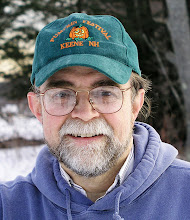I often say that much
of what I know about photography comes from teaching classes and writing my
weekly blog. That is particularly true when I get asked questions that I can't easily answer.
Whence Cometh f Numbers?
 |
| f numbers, Where Dragons Dwell |

Of course, I have always known the f stop sequence. I understood that f/8 represented an aperture that is half the size of f/5.6, but I never felt that I needed to understand the origin of this, seemingly nonsensical progression.
 Suddenly, it bothered me that I had such a minimal understanding of this
fundamental aspect of camera function. The result of this revelation was
a two-part search. The first to understand the explanation myself, and
secondly to find a way to explain it to future students. It wasn’t easy, especially
because the explanation involves MATH!, including inverse ratios and squares,
but it was worth the effort. Not only did it clarify the weird f stop
sequence, but it also explained other mysteries of lens function. You can
check it out in my Exposure article from November 2014 (I hid my explanation at
the bottom of the article!).
Suddenly, it bothered me that I had such a minimal understanding of this
fundamental aspect of camera function. The result of this revelation was
a two-part search. The first to understand the explanation myself, and
secondly to find a way to explain it to future students. It wasn’t easy, especially
because the explanation involves MATH!, including inverse ratios and squares,
but it was worth the effort. Not only did it clarify the weird f stop
sequence, but it also explained other mysteries of lens function. You can
check it out in my Exposure article from November 2014 (I hid my explanation at
the bottom of the article!).  It
was a valuable process of exploration and discovery, all coming from a simple question, and a
question that I never thought required an answer. Just one example of how
my need to explain photography to my students has led to my own education.
And, this week, it happened again.
It
was a valuable process of exploration and discovery, all coming from a simple question, and a
question that I never thought required an answer. Just one example of how
my need to explain photography to my students has led to my own education.
And, this week, it happened again.
Introduction to Digital Photography - The Question
 |
| Abby at f/3.5, Nice Shallow DOF |
 |
| Peggy's Cove Sunset, Nova Scotia Small Aperture: Deep Depth of Field |
But the question was asked, and I knew that I couldn’t expect any sleep until I understood the answer sufficiently to explain it to my students. Happily, the solution is straight forward and in no way related to a deity. I thought I had a superficial understanding, but I found a diagram from Wikipedia that I was able to modify to demonstrate the phenomena more clearly.

The upper and lower figures show the imaging of three objects at different distance from the lens. The top is seen through a wide aperture and the bottom through a smaller. In both cases the lens is focused on the center dot (2) and dots 1 and 3 are further and nearer respectively. For me the essential thing to note is that, regardless of aperture, all three dots are brought to a point of sharp focus (purple dot), but only 2 (blue) reaches that focus on the surface of the sensor. The rays from Dot 1 (red), which is the most distant, converges on a point in front of the sensor. By the time the rays reach the sensor plane they have spread, and therefore the image does not appear sharp. The focus point for the near dot (3) (green) is at an imaginary point converging at the back of the sensor, and therefore also leaves a blurred image.
 In
the top figure, the wide aperture gathers more light, but the wider opening
results in a more drastically splayed distribution of rays, leading to a
bigger area of blur. These areas of blur are often referred to as “Zones
of Confusion” (Green Bracket) and, when the zone is big enough, the subject
will appear out of focus.
In
the top figure, the wide aperture gathers more light, but the wider opening
results in a more drastically splayed distribution of rays, leading to a
bigger area of blur. These areas of blur are often referred to as “Zones
of Confusion” (Green Bracket) and, when the zone is big enough, the subject
will appear out of focus.
In
the bottom figure the smaller aperture leads to a more columnated distribution
of the rays. This leads to a darker exposure, but also the most
drastically splayed rays are blocked. The focus point for each dot is the
same but, because of the small aperture, the rays reach the sensor with a
smaller area of blur, and the “Zone of Confusion” can be small enough that our
eyes may see them as sharp. Furthermore, with a small aperture, the
subjects can be further from the point of perfect focus before the dot spread
(the zone of confusion) is enough to appear blurry.
This is why a large aperture has a smaller depth of
field.
QED.
Shifting Sensor Plane
 |
| Shifted Sensor for Increased DOF |
I
can’t wait to lay this stuff on the next meeting of my class! That will teach them to ask questions I can’t
answer!


No comments:
Post a Comment